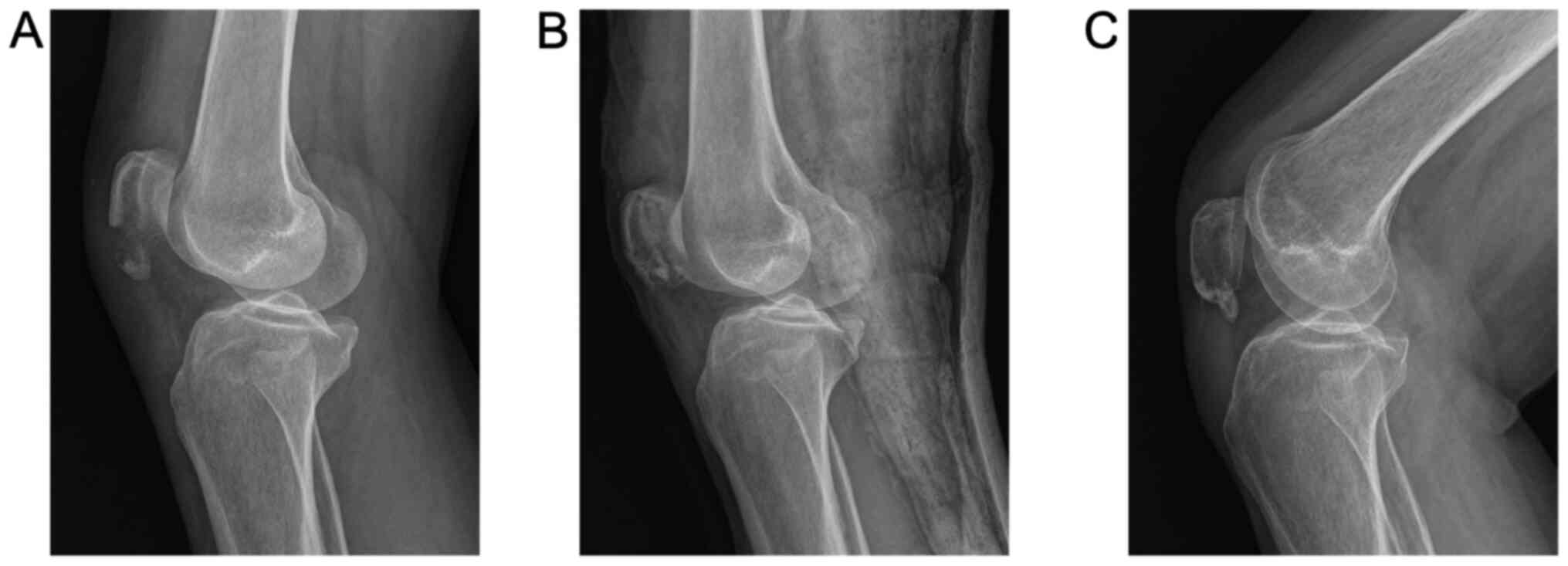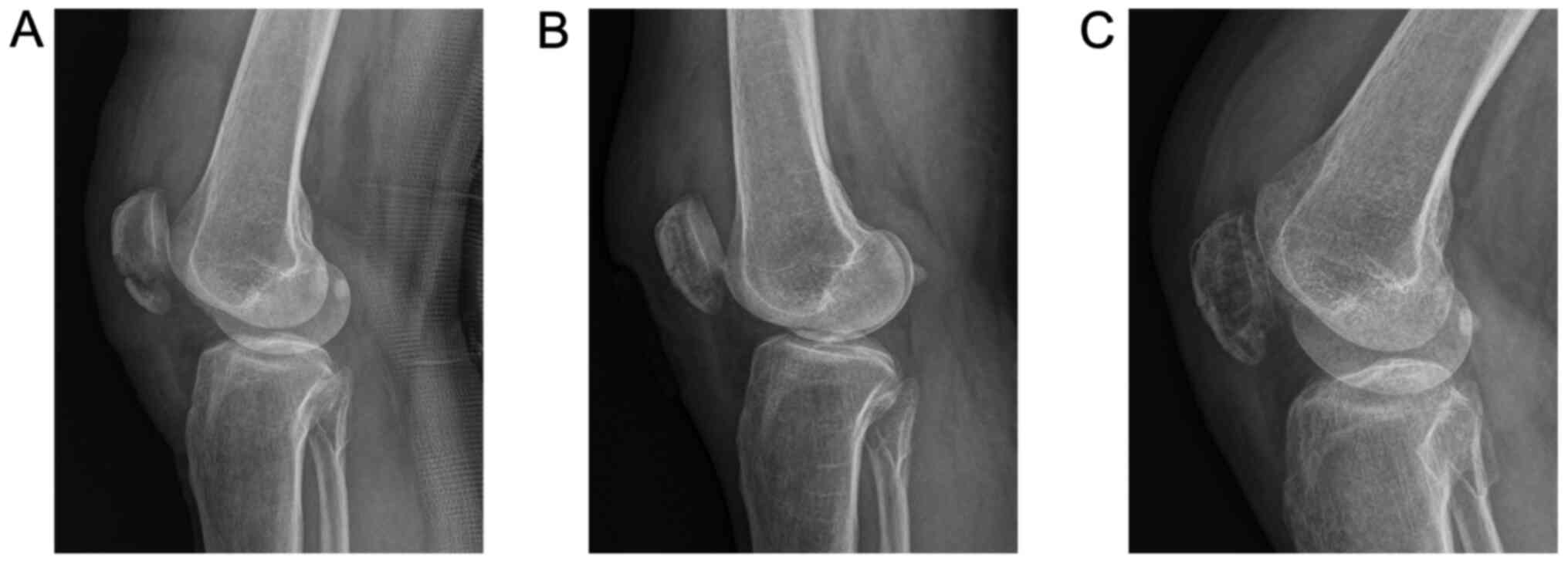|
1
|
Yang X, Wu Q, Lai CH and Wang X:
Management of displaced inferior patellar pole fractures with
modified tension band technique combined with cable cerclage using
Cable Grip System. Injury. 48:2348–2353. 2017.PubMed/NCBI View Article : Google Scholar
|
|
2
|
Oh HK, Choo SK, Kim JW and Lee M: Internal
fixation of displaced inferior pole of the patella fractures using
vertical wiring augmented with Krachow suturing. Injury.
46:2512–2515. 2015.PubMed/NCBI View Article : Google Scholar
|
|
3
|
Veselko M and Kastelec M: Inferior
patellar pole avulsion fractures: Osteosynthesis compared with pole
resection. Surgical technique. J Bone Joint Surg Am. 87 (Suppl
1):S113–S121. 2005.PubMed/NCBI View Article : Google Scholar
|
|
4
|
Matejcic A, Puljiz Z, Elabjer E,
Bekavac-Beslin M and Ledinsky M: Multifragment fracture of the
patellar apex: Basket plate osteosynthesis compared with partial
patellectomy. Arch Orthop Trauma Surg. 128:403–408. 2008.PubMed/NCBI View Article : Google Scholar
|
|
5
|
He S, Huang X, Yan B, Zhu J, Bao N and
Zhao J: Modified technique of separate vertical wiring for the
fixation of patellar inferior pole fracture. J Orthop Trauma.
32:e145–e150. 2018.PubMed/NCBI View Article : Google Scholar
|
|
6
|
Song HK, Yoo JH, Byun YS and Yang KH:
Separate vertical wiring for the fixation of comminuted fractures
of the inferior pole of the patella. Yonsei Med J. 55:785–791.
2014.PubMed/NCBI View Article : Google Scholar
|
|
7
|
Chang SM and Ji XL: Open reduction and
internal fixation of displaced patella inferior pole fractures with
anterior tension band wiring through cannulated screws. J Orthop
Trauma. 25:366–370. 2011.PubMed/NCBI View Article : Google Scholar
|
|
8
|
Kastelec M and Veselko M: Inferior
patellar pole avulsion fractures: Osteosynthesis compared with pole
resection. J Bone Joint Surg Am. 86:696–701. 2004.PubMed/NCBI View Article : Google Scholar
|
|
9
|
Egol K, Howard D, Monroy A, Crespo A,
Tejwani N and Davidovitch R: Patella fracture fixation with suture
and wire: You reap what you sew. Iowa Orthop J. 34:63–67.
2014.PubMed/NCBI
|
|
10
|
Swensen S, Fisher N, Atanda A and Egol KA:
Suture repair of a pole patella fracture. J Orthop Trauma. 31
(Suppl 3):S28–S29. 2017.PubMed/NCBI View Article : Google Scholar
|
|
11
|
Anand A, Kumar M and Kodikal G: Role of
suture anchors in management of fractures of inferior pole of
patella. Indian J Orthop. 44:333–335. 2010.PubMed/NCBI View Article : Google Scholar
|
|
12
|
Kadar A, Sherman H, Drexler M, Katz E and
Steinberg EL: Anchor suture fixation of distal pole fractures of
patella: Twenty seven cases and comparison to partial patellectomy.
Int Orthop. 40:149–154. 2016.PubMed/NCBI View Article : Google Scholar
|
|
13
|
Patel VR, Parks BG, Wang Y, Ebert FR and
Jinnah RH: Fixation of patella fractures with braided polyester
suture: A biomechanical study. Injury. 31:1–6. 2000.PubMed/NCBI View Article : Google Scholar
|
|
14
|
Wright PB, Kosmopoulos V, Coté RE, Tayag
TJ and Nana AD: FiberWire is superior in strength to stainless
steel wire for tension band fixation of transverse patellar
fractures. Injury. 40:1200–1203. 2009.PubMed/NCBI View Article : Google Scholar
|
|
15
|
Castrejón I, Chua JR and Pincus T: A
RheuMetric physician checklist to quantitate levels of
inflammation, damage and distress on 0-10 visual analogue scales.
Clin Exp Rheumatol. 35 (Suppl 107):S21–S25. 2017.PubMed/NCBI
|
|
16
|
Bostman O, Kiviluoto O and Nirhamo J:
Comminuted displaced fractures of the patella. Injury. 13:196–202.
1981.PubMed/NCBI View Article : Google Scholar
|
|
17
|
Lysholm J and Gillquist J: Evaluation of
knee ligament surgery results with special emphasis on use of a
scoring scale. Am J Sports Med. 10:150–154. 1982.PubMed/NCBI View Article : Google Scholar
|
|
18
|
Massoud EIE: Repair of comminuted fracture
of the lower patellar pole. Ulus Travma Acil Cerrahi Derg.
23:150–155. 2017.PubMed/NCBI View Article : Google Scholar
|
|
19
|
Matejčić A, Ivica M, Jurišić D, Ćuti T,
Bakota B and Vidović D: Internal fixation of patellar apex
fractures with the basket plate: 25 years of experience. Injury. 46
(Suppl 6):S87–S90. 2015.PubMed/NCBI View Article : Google Scholar
|
|
20
|
Huang HC, Su JY and Cheng YM: Modified
basket plate for inferior patellar pole avulsion fractures: A
report of three cases. Kaohsiung J Med Sci. 28:619–623.
2012.PubMed/NCBI View Article : Google Scholar
|
|
21
|
Camarda L, La Gattuta A, Butera M,
Siragusa F and D'Arienzo M: FiberWire tension band for patellar
fractures. J Orthop Traumatol. 17:75–80. 2016.PubMed/NCBI View Article : Google Scholar
|
|
22
|
Shea GK, Hoi-Ting So K, Tam KW, Yee DK,
Fang C and Leung F: Comparing 3 different techniques of patella
fracture fixation and their complications. Geriatr Orthop Surg
Rehabil. 10(2151459319827143)2019.PubMed/NCBI View Article : Google Scholar
|
|
23
|
LeBrun CT, Langford JR and Sagi HC:
Functional outcomes after operatively treated patella fractures. J
Orthop Trauma. 26:422–426. 2012.PubMed/NCBI View Article : Google Scholar
|
|
24
|
McGreal G, Reidy D, Joy A, Mahalingam K
and Cashman WF: The biomechanical evaluation of polyester as a
tension band for the internal fixation of patellar fractures. J Med
Eng Technol. 23:53–56. 1999.PubMed/NCBI View Article : Google Scholar
|
|
25
|
Gaines RJ, Grabill SE, DeMaio M and Carr
D: Patellar tendon repair with suture anchors using a combined
suture technique of a Krackow-Bunnell weave. J Orthop Trauma.
23:68–71. 2009.PubMed/NCBI View Article : Google Scholar
|
|
26
|
Petri M, Dratzidis A, Brand S, Calliess T,
Hurschler C, Krettek C, Jagodzinski M and Ettinger M: Suture anchor
repair yields better biomechanical properties than transosseous
sutures in ruptured quadriceps tendons. Knee Surg Sports Traumatol
Arthrosc. 23:1039–1045. 2015.PubMed/NCBI View Article : Google Scholar
|
|
27
|
Derwin KA, Sahoo S, Zajichek A, Strnad G,
Spindler KP, Iannotti JP and Ricchetti ET: Tear characteristics and
surgeon influence repair technique and suture anchor use in repair
of superior-posterior rotator cuff tendon tears. J Shoulder Elbow
Surg. 28:227–236. 2019.PubMed/NCBI View Article : Google Scholar
|
|
28
|
Sherman SL, Black B, Mooberry MA, Freeman
KL, Gulbrandsen TR, Milles JL, Evans L, Flood D and Pfeiffer F:
Biomechanical evaluation of suture anchor versus transosseous
tunnel patellar tendon repair techniques. J Knee Surg. 32:825–832.
2019.PubMed/NCBI View Article : Google Scholar
|
















